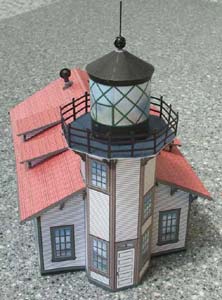


Point Cabrillo, California
 Although Point Cabrillo was surveyed by the U. S. Lighthouse Service in 1873, construction of the Light Station didn't begin until after the 1906 earthquake. The demand for lumber to rebuild San Francisco meant that maritime commerce on the north coast was at an all time high and a Lighthouse was critical to the safety of the ships and their valuable cargo. Construction of the Light Station began in 1908, and the lens was illuminated for the first time on June 10,1909, under head keeper Wilhelm Baumgartner.
Although Point Cabrillo was surveyed by the U. S. Lighthouse Service in 1873, construction of the Light Station didn't begin until after the 1906 earthquake. The demand for lumber to rebuild San Francisco meant that maritime commerce on the north coast was at an all time high and a Lighthouse was critical to the safety of the ships and their valuable cargo. Construction of the Light Station began in 1908, and the lens was illuminated for the first time on June 10,1909, under head keeper Wilhelm Baumgartner.
What people say...
Oh,Wow ! You guys have out-done yourselves this time. The reflections in the glass of the surrounding countryside are fantastic. Nobody else has done that sort of thing. Lining up the light glass with the window panes will be a tad more work, but well worth it. Thanks for the really nice model. ymp, John
 Baumgartner
invited the neighbors and residents of Pine Grove to attend the
midnight ceremony.
Baumgartner
invited the neighbors and residents of Pine Grove to attend the
midnight ceremony. in 1935
in 1935

